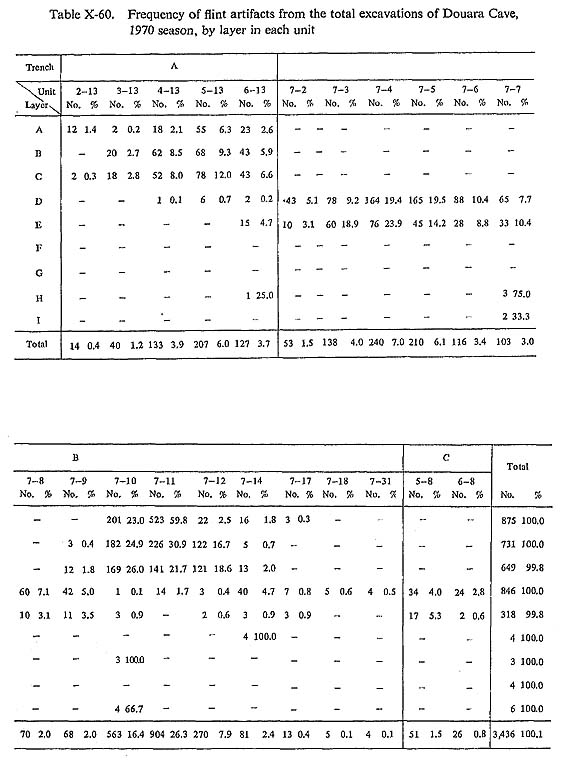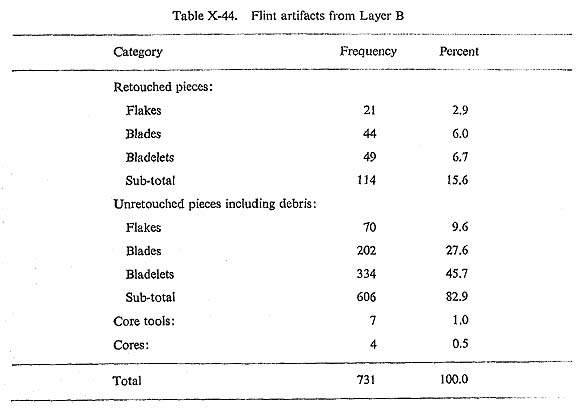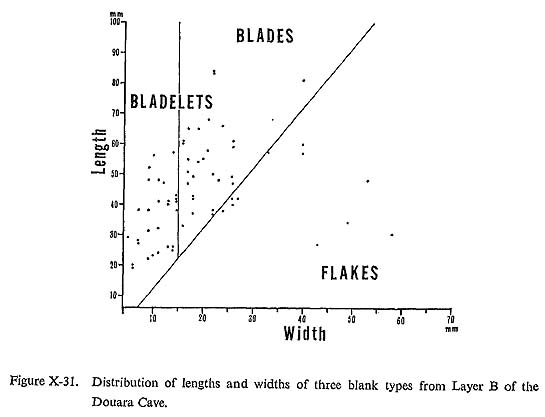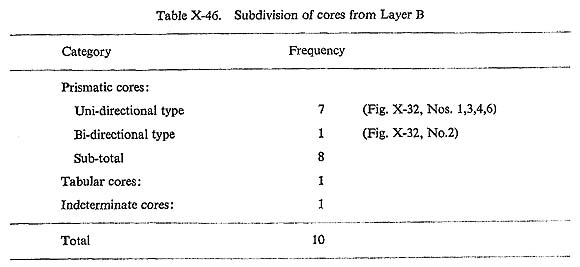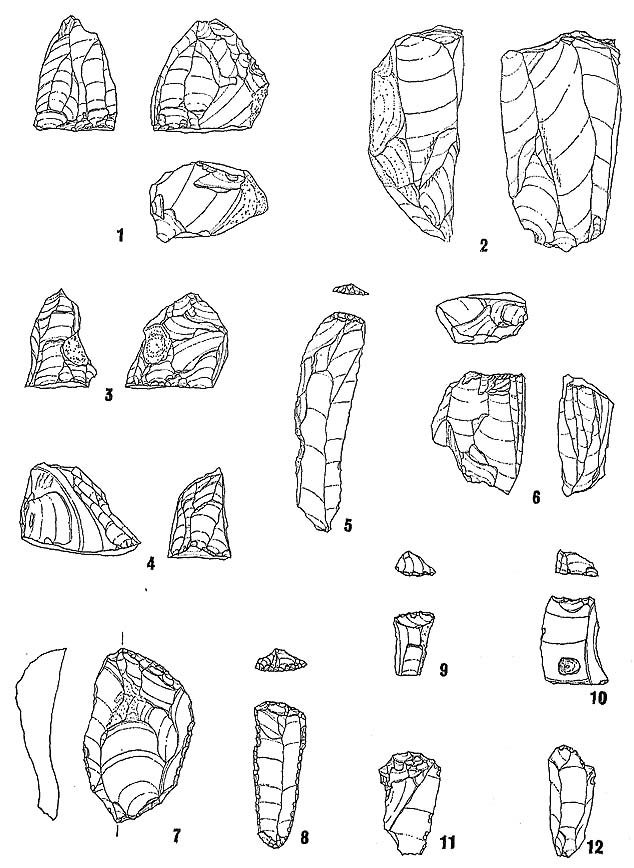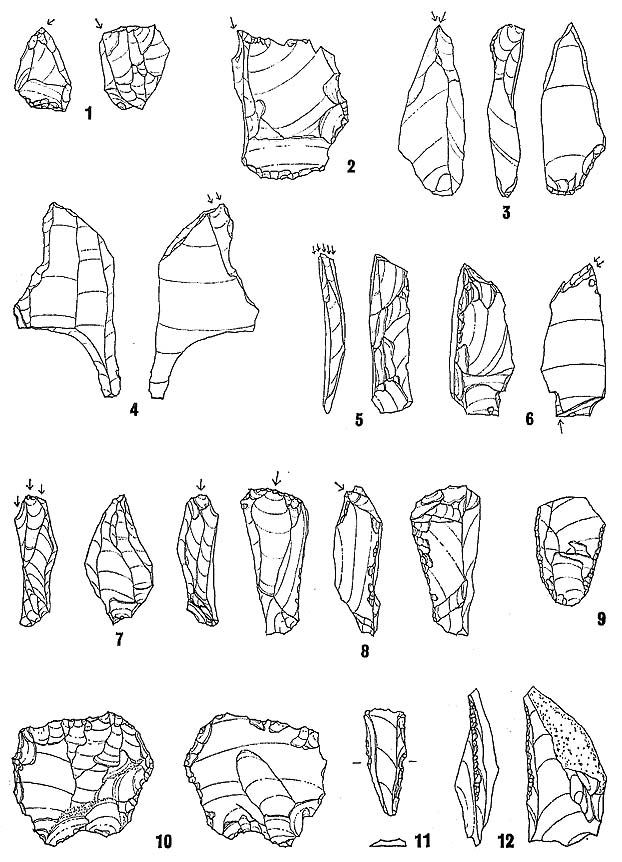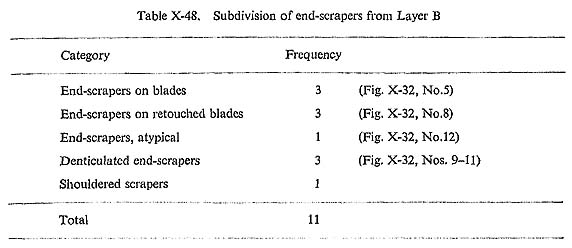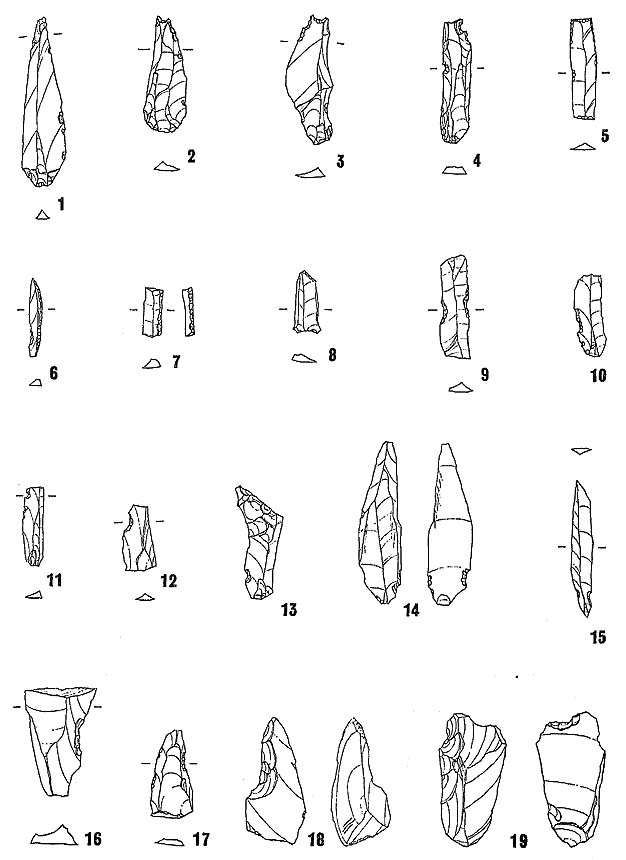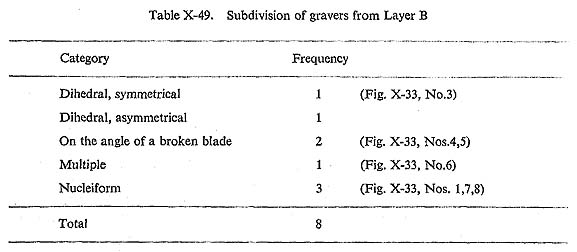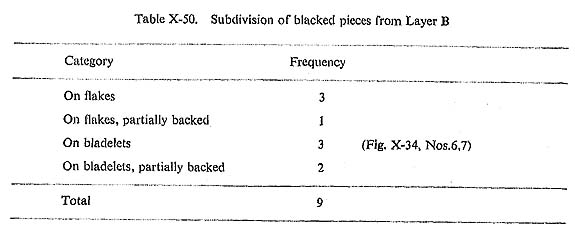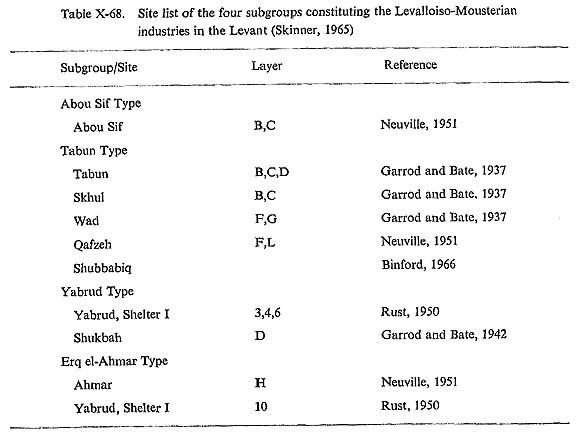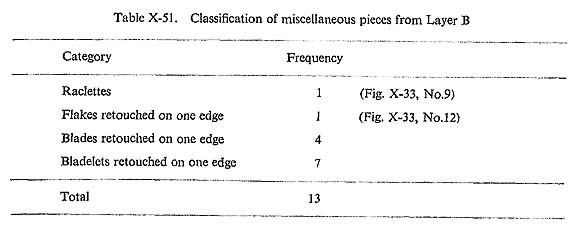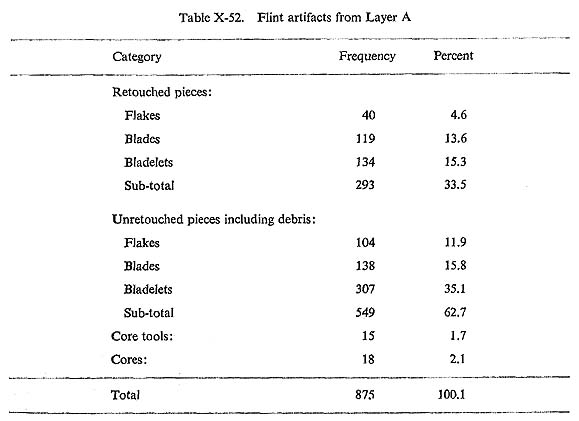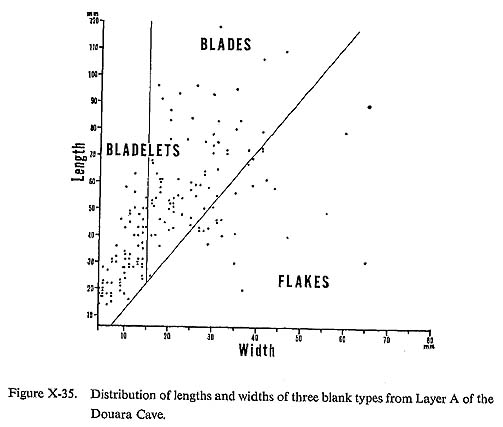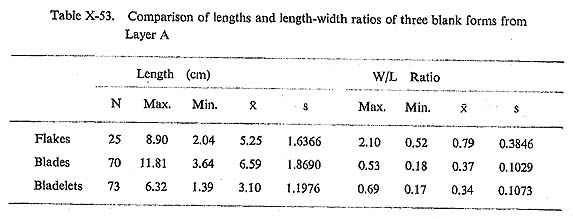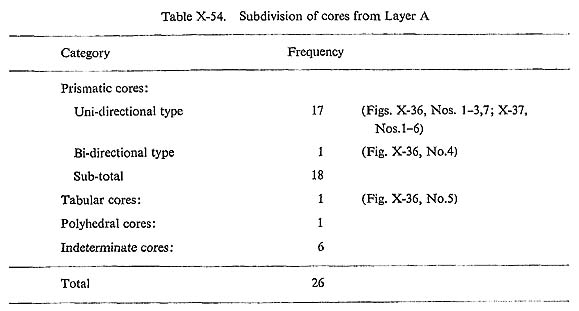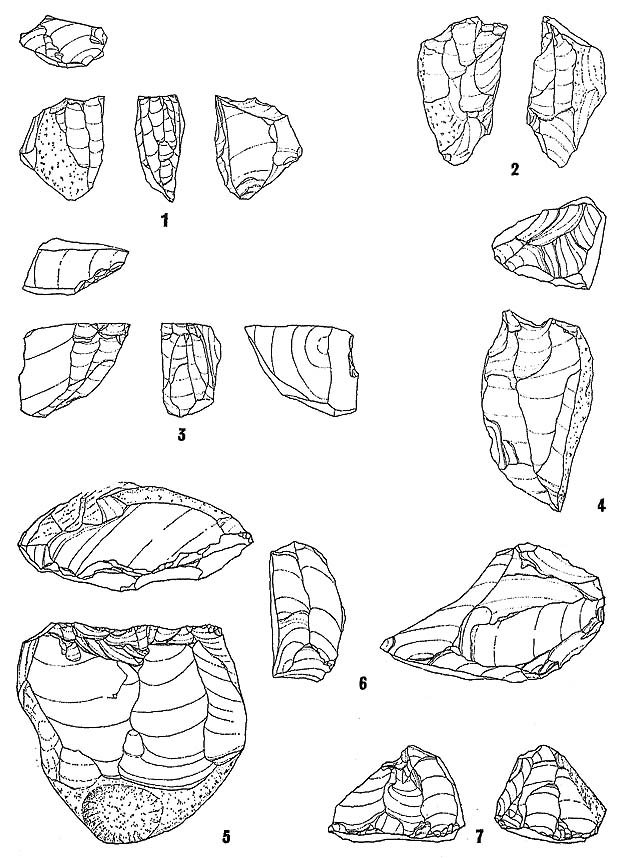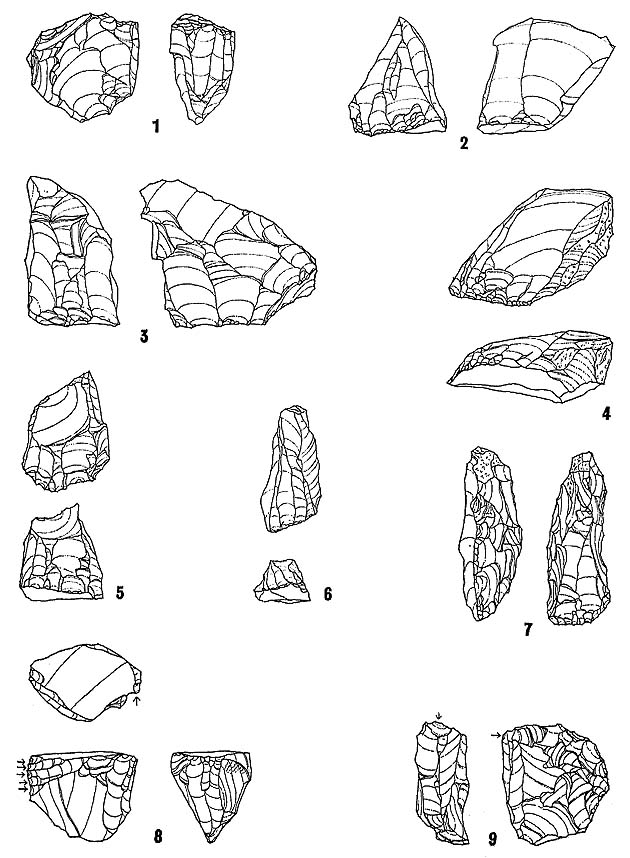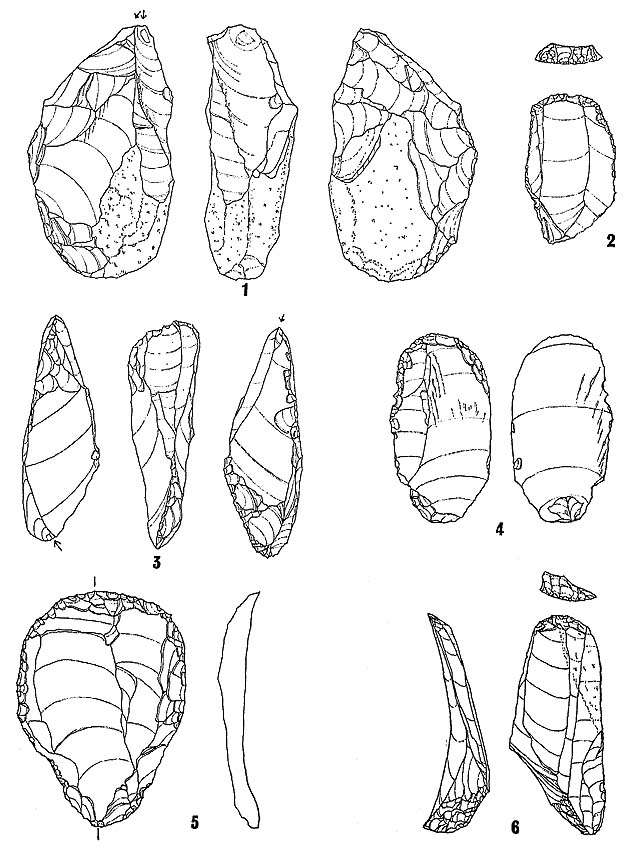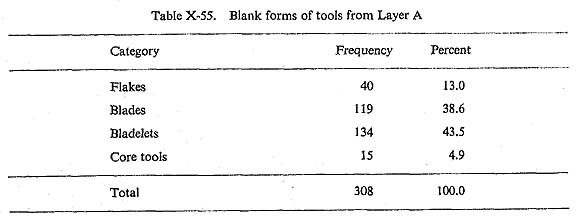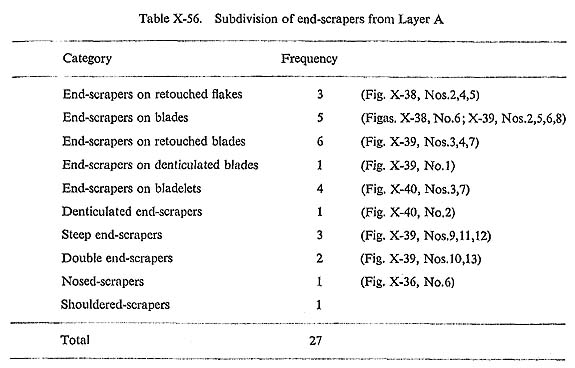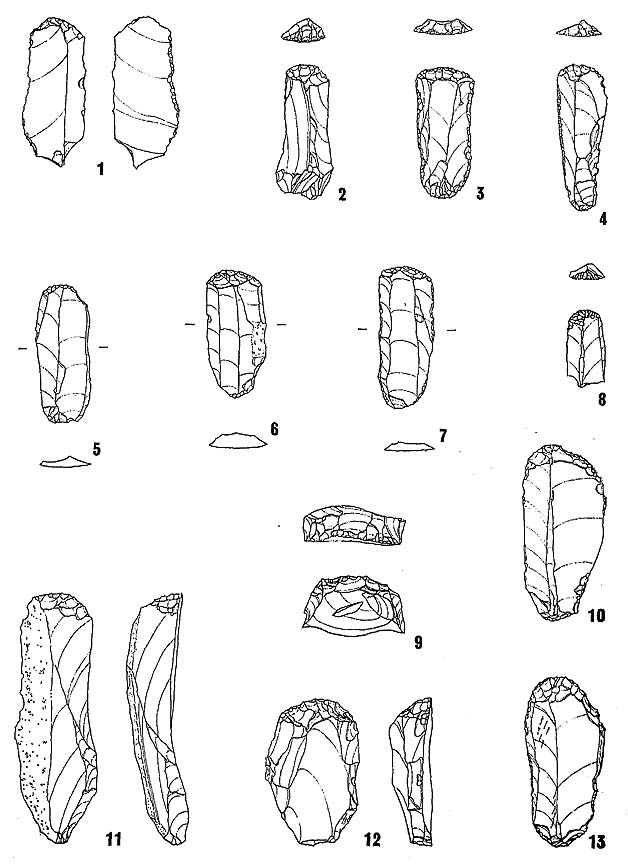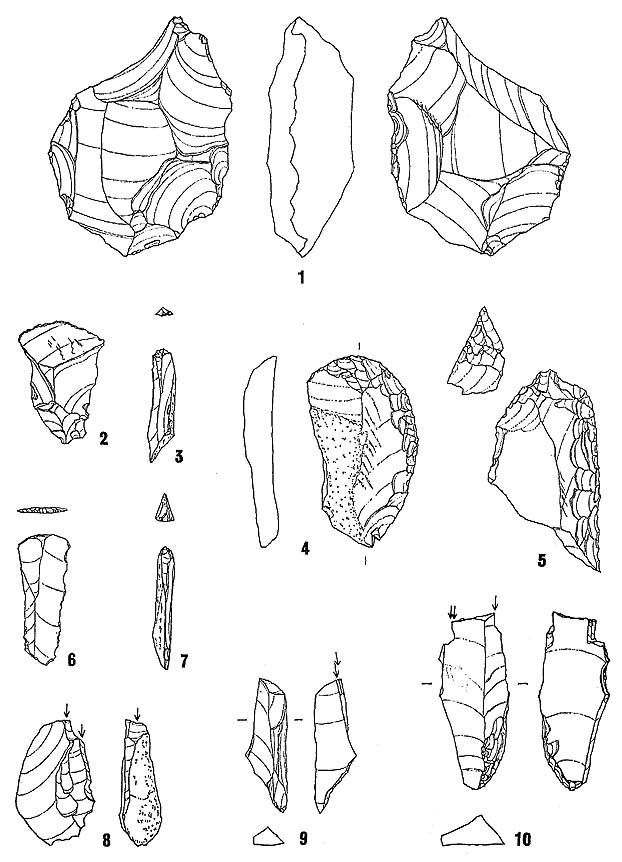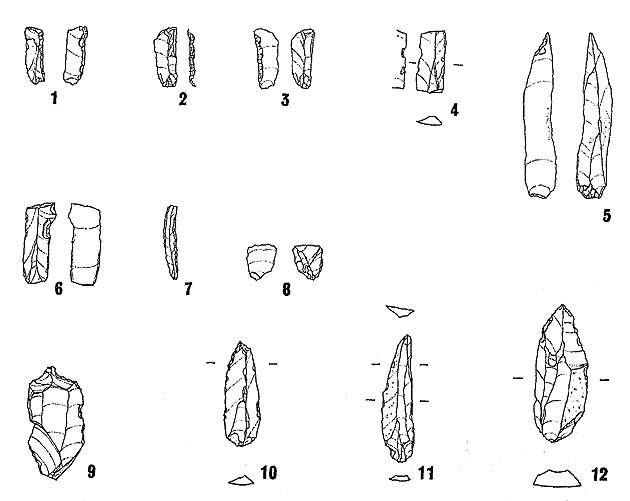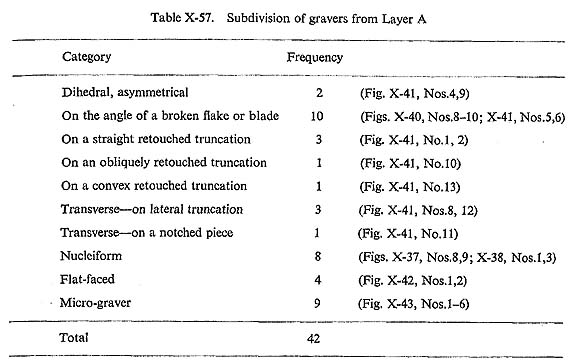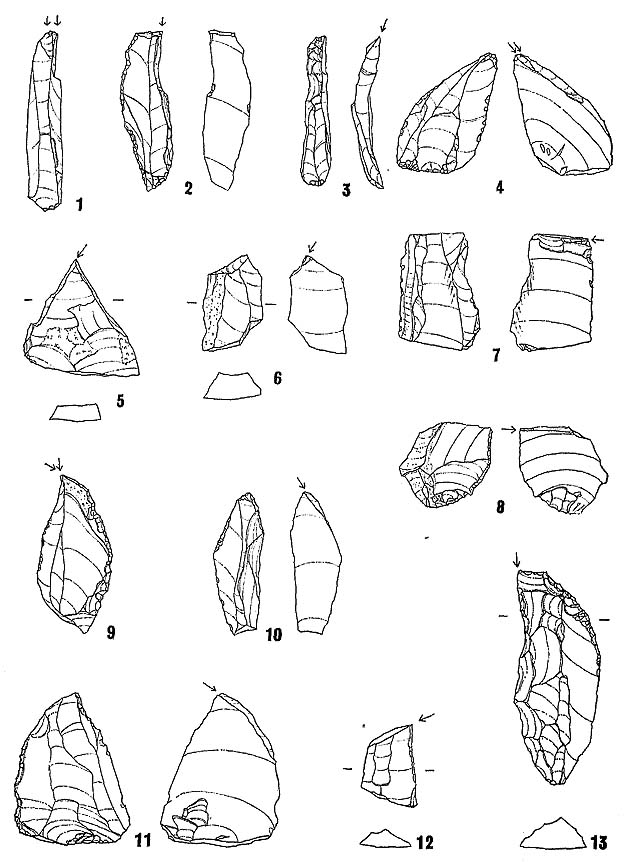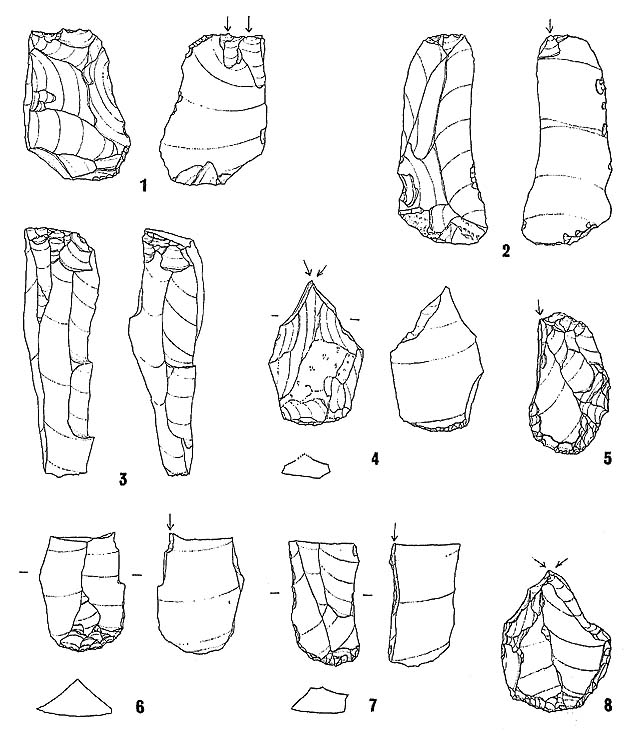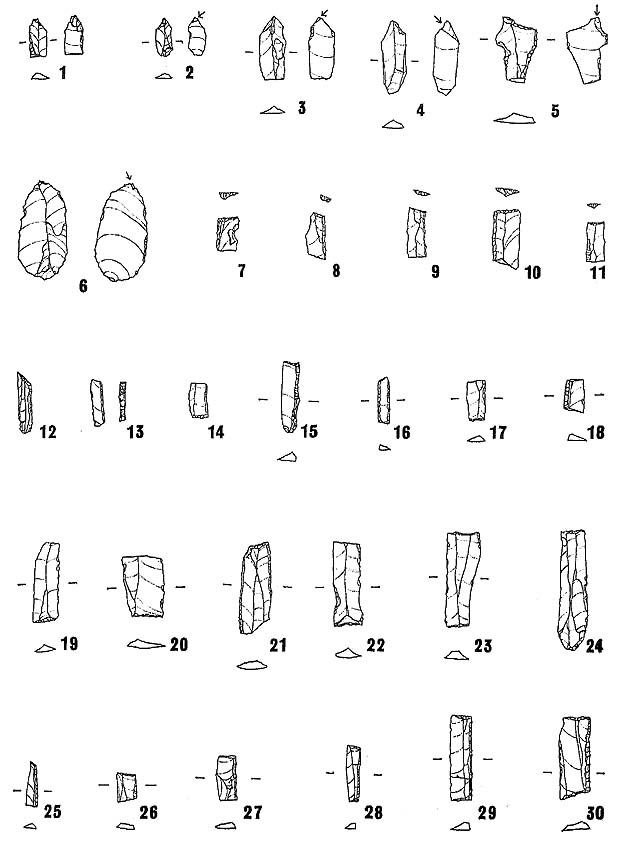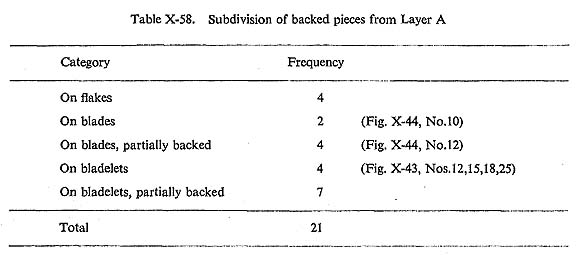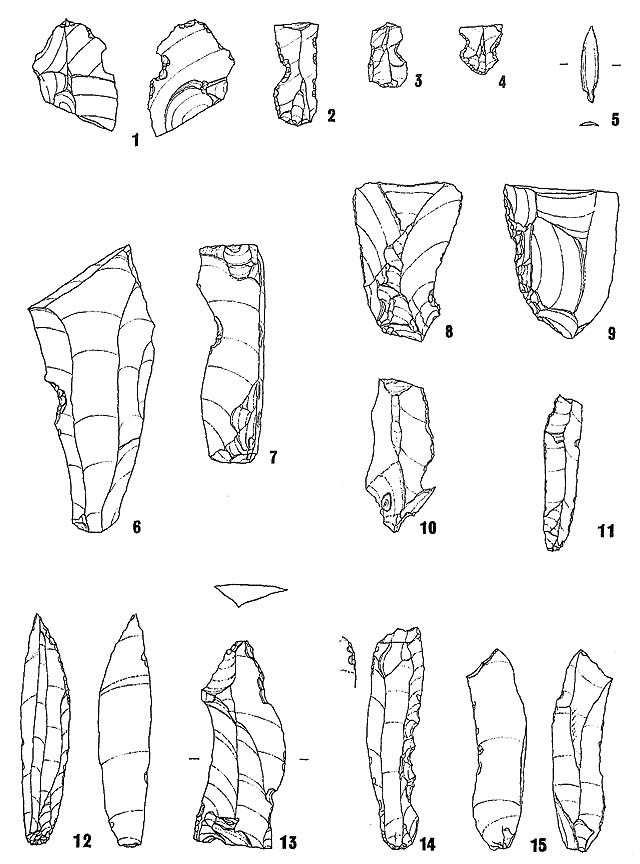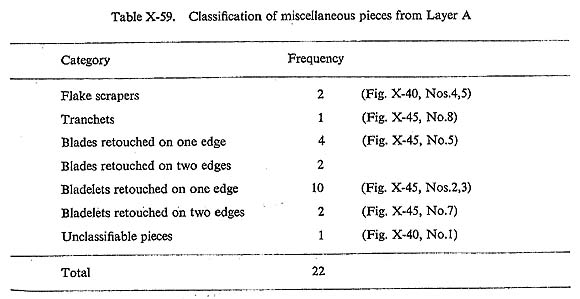CHAPTER X
PALAEOLITHIC ASSEMBLAGES FROM THE DOUARA CAVE SITE
Takeru AKAZAWA
Department of Anthropology and Prehistory, The University Museum, The University of Tokyo
| ( 4 / 7 ) |
LAYER B: UPPER PALAEOLITHICThe flint artifacts from Layer B are from five units in the outer end of Trench B and four units in Trench A (Table X-60). The description of these artifacts is based on 114 retouched specimens of all types, seven core tools, four cores and 606 unretouched specimens of all types including debris (Table X-44). The flint artifacts in this layer are generally patinated brown to dark brown. A large number of them have variable amounts of calcareous concretions adhering to their surfaces.
TECHNOLOGICAL DESCRIPTIONBlanksThere are four types of blanks-flakes, blades, bladelets, and cores (Table X-44). The classification of the blanks into flakes, blades and bladelets is mainly based on their lengths and length-width ratios. They are not classified according to the distinction of flaking technique, such as the Levallois or non-Levallois technique. Accordingly, blanks produced by the same technique are segregated into different groups, such as flake or blade. The definitions of three blank types described in this paper are as follows: a flake is defined as a broad piece whose length is less than twice its width; a blade is defined as a piece whose length is twice or more its width; and a bladelet is defined as a blade or flake whose maximum width is 1.5 cm or less. However, the distinction between these three types is rather arbitrary (Fig. X-31); there is no suggestion of bimodal distributions of lengths or widths.
Table X-45 shows the maximum, minimum and mean lengths and length-width ratios for flake, blade and bladelet blanks in Layer B.
CoresThe cores from this layer fall into three categories: prismatic, tabular and indeterminate (Table X-46).
The prismatic core is the dominant type core in this layer. It is subdivided into two types -uni-directional and bi-directional-on the basis of direction of the main flaking scars (Figs. X-32, Nos. 1, 4, 6; X-33, No. 1). Some prismatic cores have been modified and fall within the ranges of core-scrapers (Fig. X-32, Nos. 1, 3, 4) and gravers of nucleiform type (Fig. X-33, No. 1).
The one tabular type core has uni-directional flaking scars and a large amount of cortex on the reverse surface (opposite the main flaking surface). The fragmentary core has a number of flaking scars on its surface. Most of the cores are samll enough to have produced blades or bladelets less than 5 cm long. The prismatic core with bi-directional flaking scars is large enough to have produced blades as denned in the present report (Fig. X-32, No. 2). TYPOLOGICAL DESCRIPTIONOf the 731 flint artifacts in this layer, a total of 121 are classifiable as tools with secondary retouch (Table X-47). The majority of these tools, nearly 80 percent, are made on blades or bladelets. The tools made on flakes are much fewer and account for about 20 percent of the total tools.
End-scrapers (11 pieces) These pieces are generally characterized by having a round working edge formed by abrupt or semi-abrupt retouch at the distal end of a flake or blade. The blank forms on which these scrapers are made fall into two categories-flake (1) and blade (10). These end-scrapers are divided into several subtypes based mainly on the morphological and technological characteristics of the working edge. Table X-48 shows the relative quantity of each subtype.
Of these 11 specimens, end-scrapers on blades are the most abundant type (6). These generally are characterized by rounded and more or less thin working edges formed by abrupt or semi-abrupt, regular retouch at the distal end. Three of them are made on blades retouched on both leteral margins (Fig. X-32, No. 8). The one atypical end-scraper has the working edge at the distal end and not so extensive retouch shaping the edge (Fig. X-32, No. 12). The three denticulated end-scrapers are characterized by working edges formed by a contiguous series of retouches forming an indentation along the distal end (Fig. X-32, Nos. 9-11). On two the working edge is rounded in outline but on one it is roughly straight (Fig. X-32, No. 10). The shouldered end-scraper is not typical: the retouch shaping the working edge is not extensive enough to form a typical shouldered edge with a notch. This piece is made on a flake. Steep-scrapers (1 piece) This specimen is made on a thick flake and has a steep working edge along its distal end and right edge. The working edge at the distal end is well-made by regular, parallel retouching, but the right margin is only slightly retouched (Fig. X-32, No. 7). Core-scrapers (3 pieces) One piece classifiable as a core-scraper has working edges formed by irregular but exten sive retouch along approximately half the edge of a core (Fig. X-32, No. 3). This core is pro bably part of a prismatic core. Two pieces also included with the prismatic core show signs of being secondarily modified into core-scrapers and there is secondary retouch along the ends of several main flaking scars on the cores (Fig. X-32, Nos. 1, 4). Perforators (9 pieces) These perforators have prominent projection tips formed by a series of abrupt retouches or notches along the margin of a flake, usually at the distal end. The blanks for these imple ments are flakes (2), blades (5) and bladelets (2). The two perforators made on flakes are prominent projections at the distal end of the blank. The retouching is abrupt and generally on the dorsal surface. The seven perforators on blades and bladelets generally are characterized by a tiny but prominent projection tip at the distal end. Either a series of contiguous retouches forming a notch (Fig. X-34, Nos. 2-4), or a single retouch was used to form the tip (Fig. X-34, No. 1). All retouch scars are on the dorsal surface.
Gravers (8 pieces) The graver usually is the most common tool type in Upper Palaeolithic assemblages. But in Layer B of Douara Cave it makes up only 6.6 percent of the total specimens classifiable as tools. These gravers are subdivided mainly according to the number and location of the graver facets. The types of gravers from this layer are given in Table X-49.
All these gravers are classified as typical because the chisel-like working edge is clear. The two dihedral gravers have the chisel-like working edges formed by the intersections of a number of adjacent spall removals: one is symmetrical (Fig. X-33, No. 3) and one is asymmetrical. The working edge of the angle graver is formed by the intersection of a spall removal with the snapped edge of a broken blade (Fig. X-33, Nos. 4, 5). The multiple graver has one facet formed by a transversal removal at one end and another facet formed by the intersection of a spall removal and the angle of the snapped edge of a blade (Fig. X-33, No. 6). The three nucleiform gravers are generally characterized by chisel-like working edges formed by several spall removals on more than one edge of a core. Two are prismatic cores (Fig. X-33, Nos. 7, 8) and one is a fragmentary core (Fig. X-33, No. 1). Most of the graver facets are small and clearly differ from the main flaking scars in both morphological features and position. Composite Tools (1 piece) A composite tool is defined as two or more different tools on the same piece of flint. The single composite tool from this layer has an end-scraper and a graver on opposite ends of the same flake (Fig. X-33, No. 2). The scraper edge is formed by semi-abrupt, regular retouch, and the graver edge is formed by the intersection of a spall removal with the angle of a snapped edge. Backed Pieces (9 pieces) These nine specimens are flakes (4) and bladelets (5) with one margin blunted by regular, abrupt retouch along part or all of that margin (Table X-50).
The flakes are blunted on either the proximal or distal part of one lateral margin. Three of the flakes are broken pieces. Two of the bladelets are backed on only part of one lateral margin (Fig. X-34, Nos. 6,7). One is typical with one entire lateral margin blunted. The blunted edge of this piece is formed by extensive, regular abrupt retouching intentionally giving the piece a curved back and an obliquely pointed tip (Fig. X-34, No. 6). It possibly belongs to the general group of Kebarah points (Turville-Petre, 1932). Truncated Pieces (6 pieces) These pieces are characterized by abrupt, regular retouch along varying portions of their edges, usually at the distal or proximal ends. The blanks for these tools are blades (1) and bladelets (5). One piece is truncated by steep retouches obliquely to the long axis of a broken blade. Four other pieces are straight (1), concave (2) or oblique straight (1) truncations at either the distal or proximal end of a broken bladelet (Fig. X-34, No. 8). The sixth piece shows truncations at both ends of a rectangular bladelet (Fig. X-34, No. 5). This last piece is well-made and has small patches of semi-abrupt, clearly intentional retouch along both lateral margins. Notched Pieces (25 pieces) Notched pieces are quite abundant in this layer, making up 20.7 percent of the total tools (Table X-68). These pieces usually have only a single notch. The notch in most cases is formed by a series of regular, abrupt retouches cutting deeply into edge of a flake (Fig. X-34, Nos. 10-19). The retouch is from either the ventral surface or from the dorsal surface. The blanks used for these notched pieces are flakes (4), blades (10) and bladelets (11).
The notched pieces on flakes have single notches formed by a series of extensive, abrupt retouches. One of them has the notch at the distal end on the ventral surface of a flake (Fig. X-34, No. 19). The ten pieces made on blades have especially well-made notches formed by fine abrupt retouch (Fig. X-34, No. 14) and one has a large notch formed by heavy retouch (Fig. X-34, No. 18). The eleven well-made pieces made on bladelets have notches formed by fine, abrupt retouch cutting deeply into their edges (Figs. X-34, Nos. 10-12, 15). Two of these last three pieces have notches on the proximal end of the left lateral margin (Fig. X-34, No. 10), and one has a notch on the proximal end of both lateral margins (Fig. X-34, No. 15). Denticulate Pieces (35 pieces) This is the most abundant tool in this layer, making up 28.9 percent of the total specimens classifiable as tools. Included in this category are specimens which have substantially the same morphological features as those of the notched pieces already described, the difference being that denticulate pieces have a working edge formed by a contiguous series of notches (Fig. X-34, No. 9) or adjacent retouches (Fig. X-33, Nos. 10, 11). The blanks used for these tools are flakes (8), blades (9) and bladelets (18). The pieces on flakes are generally poorly made, but those on blades and bladelets are all well-made, exhibiting working edges with clear indentations. The eight specimens on flakes have the same characteristics as the denticulates from the preceding layers. The indentations are formed by a contiguous series of notches or adjacent retouches (Fig. 33, No. 10). The specimens on blades and bladelets have working edges char acterized by 1) fine, abrupt retouch with most working edges showing signs of wear from secon dary use (Fig. X-33, No. 11) or 2) a series of notches formed by fine, regular retouch, with only some of the working edges showing signs of wear (Fig. X-34, No. 9). The extent of the indented working edges is quite variable: some working edges cover all or part of only one margin, while others cover most edges (Fig. X-33, No. 10). The direction of retouch is from both the ventral and dorsal surfaces. Miscellaneous Pieces (13 pieces) The remaining flint artifacts from this layer consist of 1 raclette, and 12 miscellaneously retouched pieces that do not fit easily into any of the other tool categories. The raclette is a broken tip and along the entire margin is abrupt, regular retouch (Fig. X-33, No. 9). The miscellaneously retouched pieces have neither a scraping edge nor a truncation (Fig. X-33, No. 12). The extent of retouch varies considerably. These tools are made on flake (1), blade (4) or bladelet (7) blanks. Table X-51 gives the classification of the miscellaneous pieces.
LAYER A: UPPER PALAEOLITHICThe flint artifacts from Layer A are from five units in the outer end of Trench B and four units of Trench A (Table X-60). The following description of them is based on 293 retouched pieces of all types, 15 core tools, 18 cores and 549 unretouched pieces of all types including debris (Table X-52).
The color of the patination on the flint artifacts from this layer is substantially the same as in the preceding layer. TECHNOLOGICAL DESCRIPTIONBlanksThere are four types of blanks-flakes, blades, bladelets and cores. The terms flake, blade and bladelet are used as defined for the preceding Layer B (Fig. X-35). Table X-53 compares the maximum, minimum, mean and standard deviation of the lengths and length-width ratios of these three blank forms.
CoresThe twenty six cores from this layer consist of prismatic (18), tabular (1) and polyhedric (1) cores, and indeterminate core fragments (6) (Table X-54).
The prismatic cores are dominant in this layer (18 pieces). They are subclassified as unidirectional (17) and bi-directional (1) according to the direction of the main flaking scars. The flaking scars on the main surfaces are all very small and narrow suggesting these cores were used to produce bladelets. Eight prismatic cores have been modified by secondary retouch and fall within the range of the pieces classified as core scrapers (5) (Figs. X-36, No. 7; X-37, No. 2-7) and nucleiform gravers (3) (Figs. X-37, Nos. 8, 9; X-38, Nos. 1, 3). The tabular core has uni-directional flaking scars and a large amount of cortex on the reverse surface (opposite the main flaking surface) (Fig. X-36, No. 5). The scars on the main surface are somewhat broad, suggesting this core was used to produce flake blanks. The polyhedric core has multiple, broad flaking scars on its surfaces, suggesting it also was used to produce flake blanks.
The six indeterminate cores all have a number of flaking scars on their surfaces but are unclassifiable into a particular core type because they are fragments. TYPOLOGICAL DESCRIPTIONOf the 875 flint artifacts from this layer, 308 (including core tools) are classifiable as tools with secondary retouch (Table X-55). Most of these tools are made on blades or bladelets.
The relative quantity of tools on blades or bladelets rises to over 80 percent of the total tools, while the relative quantity of tools on flakes declines somewhat from the preceding layer to 13.0 percent. End-scrapers (27 pieces) End-scrapers are fairly common in this layer and make up 8.8 percent of the total classifiable tools. These end-scrapers are generally characterized by a more or less rounded working edge formed by abrupt or semi-abrupt retouch on the distal end of the blank. These pieces are classified into several subtypes according to the blank form, the technique used to shape the working edge and the form of the working edge. Table X-56 gives the classification of end scraper.
Two of the three retouched flake end-scrapers have somewhat steep working edges similar to the so-called steep end-scraper (Fig. X-38, Nos. 2, 4). Modification of their lateral margins consists of roughly parallel, fine retouch (Fig. X-38, Nos. 2, 4) or scaled retouch (Fig. X-38, No. 5). The five end-scrapers on blades are characterized by rounded working edges on the distal end of the blank (Figs, X-38, No. 6; X-39, Nos. 2, 5, 6, 8). The working edges are formed by semi-abrupt, fine regular retouch and have thin sections. Four of the five examples are on well made punched blades, and the fifth example is on a thick blade removed from a prismatic core. The working edges of the six end-scrapers on retouched blades have the same characteristics as those on unretouched blades; however, modification by secondary retouch is seen on the lateral margins of the blade. Five of these examples have very fine, regular retouch along the whole of one or both margins (Fig. X-39, Nos. 3, 4, 7). The sixth example has extensive, irregular, semi-abrupt retouch on the ventral surface along the left lateral margin. One end-scraper, which is classified as an end-scraper on a denticulated blade, has a single working edge on one end of a blade, cortex on one lateral margin and a denticulated edge formed by contiguous, abrupt retouches on the ventral surface of the opposite margin (Fig. X-39, No. 1).
Four end-scrapers are on bladelets. The techniques for shaping the working edges and the forms of these edges are substantially the same as those of the end-scrapers on blades (Fig. X-40, Nos. 3, 7). On two examples the working edges show signs of wear.
The three pieces classified as steep end-scrapers have basically the same features as other end-scrapers with the exception of their very steep working edges (Fig. X-39, Nos. 9, 11, 12). These steep end-scrapers are generally on thick flakes or blades. The remaining end-scrapers are all special types consisting of double end-scrapers (2), nosed-scrapers (I), and shouldered-scrapers (1). The double end-scrapers have a rounded working edge at both the distal and the proximal ends of blades (Fig. X-39, Nos. 10, 13). One of them is characterized by a series of small notches on right margin and very fine retouch along the most left margin (Fig. X-39, No. 13). The working edge of the nosed-scraper is formed by two adjacent flake removals at one end of a core (Fig. X-36, No. 6). The shouldered scraper has a single working edge at the distal end of a blade with a single shoulder formed by fine, regular retouch forming a notch. Core-scrapers (5 pieces) Five of the prismatic, blade or bladelet cores in this layer have fine secondary retouch along the top part of the main flaking surfaces and are classifiable as core scrapers (Figs. X-36, No. 7; X-37, Nos, 2-7). The working edges of these scrapers generally are characterized by an indented edge formed by retouch or a series of notches. Perforators (5 pieces) The five perforators are made on blades (3) or bladelets (2). Each specimen has a prominent projection on its distal end formed by abrupt retouch or notches (Fig, X-45, Nos. 9-12). There is a denticulate notch on the right margin of one piece.
Gravers (42 pieces) The graver generally is the most important tool class in Upper Palaeolithic assemblages. It is the dominant tool class in Layer A, making up 13.6 percent of the classifiable tools. These gravers are divided into several subclasses, mainly according to the characteristics of the graver facet. The classification of gravers from Layer A is given in Table X-57.
All these gravers have clear, chisel-like working edges and are classified as typical. The asymmetrical dihedral gravers have a working edge formed by several spalls removed from the distal end of a flake (Fig. X-41, Nos. 4, 9). One of them is made on a blank with a blunted edge along one lateral margin (Fig. X-41, No. 9).
The largest class of gravers in Layer A are those on broken flakes or blades. All these pieces are characterized by having the graver facets formed by the intersection of a spall removal with the snapped edge of the blank (Figs. X-40, Nos. 8-10; X-41, Nos. 5, 6). The five gravers on truncated blanks have typical graver facets formed by the intersection of a single spall removal with the retouched truncation. The truncations are on the distal ends of the blanks and are straight (Figs. X-41, Nos. 1, 2, X-42, No. 2), oblique (Fig. X-41, No. 10) and convex (Fig. X-41, No. 13). On one example on a straight retouched truncation, a single spall removal on the ventral surface intersects with a retouched truncation that resembles the working edge of an end-scraper (Fig. X-42, No. 2). One truncated graver has a blunt edge along the distal part of its right margin and a shallow notch made by abrupt retouch adjacent to the graver facet on its left margin (Fig. X-41, No. 13).
Four gravers had the spalls removed transversally or obliquely to the long axis of the blank. One is on a broken blade with a graver facet formed along the snapped edge (Fig. X-41, No. 7). This graver also has a small notch adjacent to the graver facet. A second transversal graver is made on a flake and is characterized by a single facet formed by transversal retouch (Fig. X-41, No. 11). This example is modified by abrupt retouch along its left margin and a shallow notch adjacent to the facet on its right margin. The remaining two transversal gravers have facets formed by the intersection of a spall scar with the blunted right edge of the blank (Fig. X-41, Nos. 8, 12). Eight gravers are made on core blanks (Figs, X-37, Nos. 8, 9; X-38, Nos. 1, 3). The core blanks are prismatic, blade or bladelet cores, modified by removing the ends of the blade or bladelet scars. This modification produces a nucleiform graver with facets generally formed by the intersection of the spall with the striking platform of the core. The four flat-faced gravers are characterized by a spall removal on the ventral surface at either the distal or the proximal end of the blank (Fig. X-42, Nos. 1, 2). Micro-gravers are the dominant tool in lithic assemblages from. the terminal Upper Palaeolithic through the Mesolithic in Western Asia. The forms of the nine micro-gravers from Douara Layer A show considerable variation. Six of them are characterized by having a tiny chisel-like working edge formed by the intersection of an obliquely snapped edge with an oblique, retouched truncation (Fig. X-43, Nos. 1-5). One of these shows extensive modification-blunting on its right margin and a small notch on its left margin (Fig. X-43, No. 5). The remaining three pieces are rather atypical; their chisel-like working edges are not made by the intersection of a snapped edge with a truncation. One is made on the angle of a broken bladelet and has a facet formed by the intersection of a tiny, vertical spall removal with the snapped edge; one is a symmetrical dihedral; and one has a very tiny oblique spall removal at its distal end (Fig. X-43, No. 6).
Composite Tools (5 pieces) The five composite tools (two or more different tools made on the same piece) found in this layer all have two working edges-an end-scraper at one end and a graver at the other end. The blanks used for these tools are somewhat thick flakes. With the exception of one piece, the striking platforms were completely removed in forming the graver facets. The end-scrapers are all on the distal end of the blank and are either thin (Fig. X-42, No. 5) or steep (Fig. X-42, Nos. 4, 6-8). The graver facets are either symmetrical dihedral (Fig. X-42, Nos. 4, 8) or angle facets intersecting with a snapped edge or the truncated faceted butt (Fig. X-42, Nos. 5-7). Backed Pieces (21 pieces) These pieces are generally characterized by a abrupt blunting along one margin. The extensiveness and location of the blunting varies considerably, covering all or part on one margin. Table X-58 gives the quantities of backed pieces subdivided according to blank form and extensiveness of blunting.
The characteristics of these backed pieces are the same as those in the preceding layer but the four partially backed pieces on blades are unique to this layer (Fig. X-44, No. 12). Most of the backed pieces are on blades or bladelets and only partially backed along their distal end forming pointed tips. The specimens made on bladelets are all well-made by very fine,abrupt regular retouch, and four of them are backed along one entire margin and are on broken fragments (Figs. X-43, Nos. 12, 15, 18, 25; X-44, Nos. 10, 12).
Truncated Pieces (16 pieces) Truncated pieces are characterized by abrupt regular retouch along one or both ends of a blade or bladelet. Three pieces are on blades and thirteen are on bladelets. Fifteen pieces are tuncated only at one end. These include the three pieces on blades, two of which have abrupt retouch at the distal end of the blank (Fig. X-40, No. 6). The third has abrupt retouch at the proximal end. These three pieces have oblique, convex (Fig. X-40, No. 6) and straight trun cations. Twelve pieces on bladelets have single, straight (2) (Fig. X-43, Nos. 20, 24), concave (3) (Fig. X-43, Nos. 11, 17), convex (3) or oblique (4) (Fig. X-43, No. 19) truncations. Two examples are modified by fine retouch along the margin (Fig. X-43, Nos. 11,17), but the others show only some signs of secondary use. Only one piece is truncated at both ends. It is on a bladelet with a concave tuncation at one end and a straight truncation at the other end (Fig. X-43, No. 23). Very fine retouch is observed along a small part of both lateral margins. Geometric Microliths (16 pieces) Three of the geometric microliths in Layer A are elongated rectagular in outline (Fig. X-43, Nos. 28-30). These pieces have abrupt, regular retouch along one lateral margin and both ends. The naturally sharp lateral margin opposed to the blunted edge shows some signs of secondary wear on these pieces. Thirteen of the geometric microliths in this layer have regular abrupt retouch along one lateral margin and one end and a snapped edge at the other end (Figs. X-43, Nos. 7-10, 13, 14, 21, 26, 27; X-45, No. 1), These pieces appear to be broken rectangular microliths, but they might be backed bladelets with single truncations. Notched Pieces (93 pieces) Notched pieces are the most abundant classifiable tools in this layer, making up 30.2 percent of the total tools (Table X-68). Their general forms are the same as those of the notched tools in the preceding layer. These tools are flakes (19) (Fig. X-44, Nos. 1, 6, 8, 9), blades (38) (Fig. X-44, Nos. 2-4,7,11,13) and bladelets (36) (Figs. X-44, No, 5; X-45, Nos. 4,6), most of which have only one notch. The notches are generally formed by fine, regular retouch cut deeply into the edge of the piece. Some examples show signs of secondary wear along the notched part. Denticulated Pieces (56 pieces) Included in this category are specimens whose edges exhibit a contiguous series of notches or retouches. The extensiveness and the location of the retouch notches making the working edge vary considerably (Fig. X-44, Nos. 14, 15). These denticulated edges are along one or both lateral margins and on either the dorsal or ventral surface. The blanks used for these tools are flakes (7), blades (19) and bladelets (30). Miscellaneous Pieces (22 pieces) The miscellaneous pieces in Layer A can be subclassified into flake scrapers (2), tranchet (1), miscellaneously retouched blades and bladelets (18) and unclassifiable pieces (1). Table X-59 shows this subdivision.
The two flake scrapers are well-made and are characterized by having the scraper edges formed by extensive scaled retouch along the right margin and a large amount of cortex on the other margins (Fig. X-40, Nos. 4, 5). The tranchet, a type rarely found, has an unretouched tranchet edge, possibly snapped, at the distal end of a bladelet (Fig. X-45, No. 8). Miscellaneously retouched pieces are made on blades and bladelets and are retouch along one (Fig. X-45, Nos. 2, 3, 5) or both lateral margins (Fig. X-45, No. 7). These modifications are clearly intentional but are less regular than the retouch on scraper edges or trun-cations. The unclassifiable piece is a fragment of a bifacially flaked core tool. On the surfaces are intentionally made flaking scars, and there is a small notch on one edge (Fig. X-40, No. 1). |
